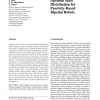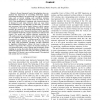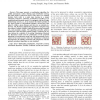5 search results - page 1 / 1 » Optimal Mass Distribution for Passivity-Based Bipedal Robots |
IJRR
2006
13 years 11 months ago
2006
This paper reports how and to what extent the mass distribution of a passive dynamic walker can be tuned to maximize walking speed and stability. An exploration of the complete pa...
ICRA
1998
IEEE
14 years 3 months ago
1998
IEEE
This paper addresses some performance limits of the kneed and non-kneed passive-dynamic walking machines discovered by McGeer [10, 11]. Energetic inefficiency is measured by the s...
ICRA
2009
IEEE
14 years 5 months ago
2009
IEEE
Abstract— Recent humanoid control investigations have emphasized the importance of controlling whole-body angular momentum throughout a movement task. For typical movement tasks,...
ROBIO
2006
IEEE
14 years 5 months ago
2006
IEEE
- Suddenly occurring collisions or unintentional motions represent a high safety risk in robotics and must be prevented. Especially for humanoid robots, the influence of disturbanc...
CORR
2006
Springer
13 years 11 months ago
2006
Springer
This paper presents a coordination algorithm for mobile autonomous robots. Relying upon distributed sensing, the robots achieve rendezvous, that is, they move to a common location....



